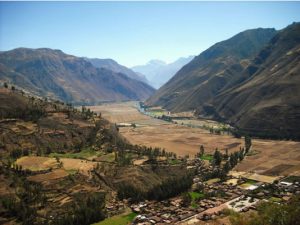Living Traditions: discovering the culture of the Sacred Valley

Time and time again we see our guests fall in love when they enter and explore the Sacred Valley of the Incas. Nestled in the heart of the Andes, less then one hour from Cusco, the Sacred Valley is more than just a breathtaking landscape—it’s a living tapestry of ancient traditions, indigenous identity,
and spiritual reverence. This region, once the heartland of the Inca Empire, continues to uphold centuries-old customs that shape everyday life for the Quechua people.
Whether you’re planning your visit or simply curious about Andean culture, let’s explore the customs of the Sacred Valley and dive into this vibrant world where the past and present merge in meaningful ways.
1. Coca Leaf: Sacred and Social
Your first association with coca leaves might be one of drug lords, crime and addiction. But actually, coca leaves have been part of everyday life in the Andes for thousands of years—not recreationally, but spiritually and medicinally. In the Sacred Valley, coca is a symbol of respect and a medium of communication with Pachamama (Mother Earth) and the Apus (mountain spirits).
Visitors are often invited to chew coca or drink coca tea to help with altitude sickness, (and it sure helps!) but locals use it in ceremonial rituals called despachos, where offerings are made to ensure harmony and balance in life. These small, ornate bundles often include coca, flowers, and sweets, and are burned or buried during sacred ceremonies. If you have the chance to experience this ceremony, who knows what
it might bring you. In the meantime, enjoy your harmless cup of tasty tea!
2. Festivals Tied to the Earth and Cosmos
Time in the Sacred Valley is deeply connected to the agricultural calendar and celestial cycles. The Inti
Raymi festival, held every June 24, honors Inti, the sun god, during the winter solstice. Though the
largest celebrations happen in Cusco, smaller, deeply rooted ceremonies take place throughout the
valley. Oftentimes these festivals combine elements of Christianity with traditional customs into a unique
celebration.
Towns like Pisac, Chinchero, and Ollantaytambo, all have their own festivals trhoughout the year.
Villagers dress in traditional clothing, play Andean music, and perform dances that reenact ancient
myths. These festivals are more than performances—they’re acts of devotion and community cohesion.
3. Traditional Weaving: Stories in Thread
Weaving in the Sacred Valley is not just a craft—it’s a cultural language. Passed down from mother to
daughter for generations, traditional weaving practices preserve sacred symbolism. Each pattern tells a
story: a mountain, a river, a crop, or a spiritual protector.
In towns and local communities, cooperatives run by Indigenous women offer demonstrations of dyeing,
spinning, and weaving with alpaca and sheep wool. These textiles are often used in daily clothing,
ceremonies, and trade, maintaining a deep connection to ancestry. We love to take you for a close and
personal encounter!
4. Communal Work: Ayni
One of the most powerful and enduring customs in the Sacred Valley is ayni, the principle of reciprocity.
In Andean worldview, life is a network of give-and-take relationships—between people, nature, and the
spiritual world. Ayni is practiced in everything from farming (neighbors help each other plant and
harvest) to building homes. It fosters strong social bonds and ensures survival in a harsh but generous
landscape. Tourists who volunteer or stay with local families often witness ayni firsthand.
5. Markets and Barter Traditions
Markets in towns like Pisac and Urubamba are more than tourist attractions—they’re the continuation of
ancient trade practices. While money is common now, barter systems (called trueque) still operate in
more remote villages, especially on designated days. These markets are also places where local customs,
music, language, and fashion come alive. You’ll see women wearing monteras (traditional hats), children
learning Quechua, and elders sharing news in ways that go back centuries.
6. Spirituality in Daily Life
In the Sacred Valley, spirituality isn’t confined to temples or ceremonies—it’s infused in the everyday.
Mountains are seen as living beings. Water is sacred. Crops are planted with prayers. It’s not uncommon
for locals to leave small offerings on the ground when drinking chicha (a traditional corn beer) or
traveling through mountain passes.
Andean spirituality is a blend of Inca beliefs and Catholic influence, resulting in festivals where saints are
paraded alongside Inca deities. This syncretism makes for vibrant, uniquely Andean expressions of faith.
A Culture That Endures
The Sacred Valley of the Incas isn’t just a relic of the past—it’s a place where ancient customs breathe
and evolve. These traditions form the backbone of community, identity, and resilience in the face of
modern challenges. The connectedness – with each other, family, the surrounding mountains and all the
new friends we make along the way might be the strongest characteristic of the Sacred Valley People,
and we can’t wait to show it to you first hand!
Have you visited the Sacred Valley or experienced Andean culture firsthand? Share your thoughts in the
comments below!
Latest Blog
From remote Andean villages to the lush Amazon Forest. Delve into Peru’s mystical past and vibrant present through our travel blog. We share captivating stories and helpful tips to inspire your Peruvian adventure.
How to Prepare for a Holiday in the Peruvian Andes (Without Losing Your Mind or Your Socks)
How to Prepare for a Holiday in the Peruvian Andes (Without Losing Your Mind or Your Socks) Time and time again we see our guests
Love in the Mountains: How We Fell for Each Other (and Peru) Twice
Love in the Mountains: How We Fell for Each Other (and Peru) Twice Some stories take a straight path. Ours zigzagged through time zones, WhatsApp

Living Traditions: discovering the culture of the Sacred Valley
Living Traditions: discovering the culture of the Sacred Valley Time and time again we see our guests fall in love when they enter and explore

